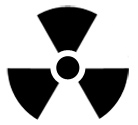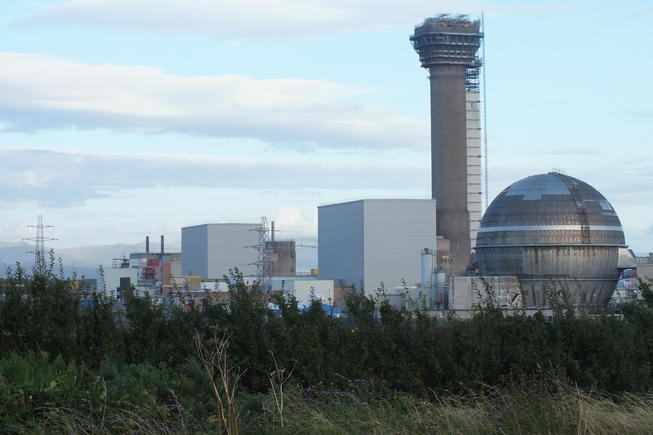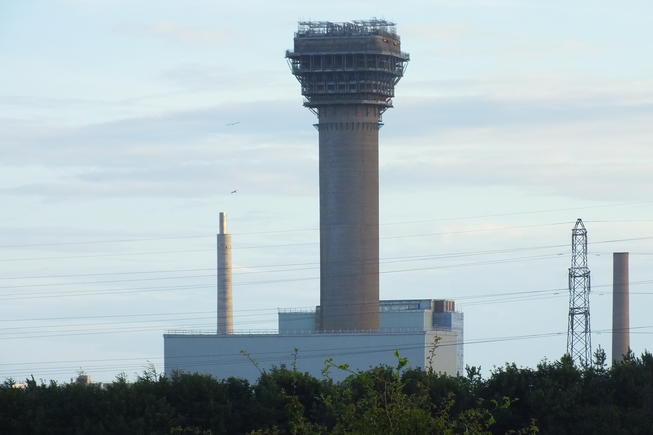
Notable Nuclear Accidents
-------------------------------------------------
 |
Notable Nuclear Accidents ------------------------------------------------- |
Chernobyl Fukushima |
Oct. 7, 1957 Overheating, induced to reduce a build up of "Wigner Energy" in this horizontal-fuel-rod reactor, caused a fire in the Windscale Pile No.1, a fan-air-cooled, military plutonium production reactor at Sellafield in Cumbria, North of Liverpool, England. This released radioactive material, escaping through the chimney and its filter system. In 1983, the British government said that 39 people had probably died of cancer as a result - most of these may have been workers directly in contact with the reactor. The Radioactive fallout had a Polonium Content, which is a long lived isotope, which was detected in Sweden after the Chernobyl incident, when measurements were taken looking for the mainly Caesium 137 short half-life fallout in 1986.
Photos of Sellafield in 2012, showing the 2 decommissioned Atomic Pile reactors. The remaining chimney has irradiated filters in the top square, contaminated in the 1957 fire. The other Atomic Pile, No.2 was closed down in 1958, after completing its fuel cycle. In the background of the photo on the left, is 1 of the 4 Calder Hall nuclear reactors, with a red heat exchanger; the first electricity generating nuclear power plant, opened in 1956. This is adjacent to, and on the left of the other Pile reactor - notice the remaining stub of its dismantled chimney. The Silver ball contained a small prototype AGR - Advanced Gas-cooled Reactor. All are now shut down. Gas Turbine generators provide power to cool the many tanks of liquid radioactive waste (disolved in Nitric Acid) from re-processing, to recover materials, like Plutonium, Tritium, and Uranium.
There is an important point here, it was realised that, with Nuclear Fission, to make Nuclear Weapons; it was necessary to burn Uranium to make Plutonium (in a reactor) so one might as well add heat exchangers and make electricity, instead of, as in the original Piles, just blowing the heat up a chimney. The Calder Hall and Chapelcross power station reactors were run to make weapons grade material.

|

|
1957 A chemical explosion in Kasli, USSR (now in Russia), in tanks containing nuclear waste, spread radioactive material and forced a major evacuation.
Jan. 3, 1961 An experimental reactor at a federal installation near Idaho Falls, ID, killed 3 workers, the only deaths in U.S. reactor operations. Radiation was contained.
Oct. 5, 1966 A sodium cooling system malfunction caused a partial core meltdown at the Enrico Fermi demonstration breeder reactor, near Detroit, MI. Radiation contained.
Jan. 21, 1969 A coolant malfunction from an experimental underground reactor at Lucens Vad, Switzerland released a large amount of radiation into a cavern, which was then sealed.
Mar. 22, 1975 A fire at the Browns Ferry reactor in Decatur, AL, burned out electrical controls, lowering the cooling water to dangerous levels.
Mar. 28, 1979 The worst commercial nuclear accident in the U.S. occurred as equipment failures and human mistakes led to a loss of coolant and a partial core meltdown at the Three Mile Island reactor in Middletown, PA.
Feb. 11, 1981 Eight workers were contaminated when over 100,000 gallons of radioactive coolant leaked into the containment building of TVA s Sequoyah 1 plant in Tennessee.
Apr. 25, 1981 Some 100 workers were exposed to radiation during repairs of a nuclear plant at Tsuruga, Japan.
Jan. 6, 1986 A cylinder of nuclear material burst after being improperly heated at a Kerr-McGee plant at Gore, OK. One worker died; 100 were hospitalized.
Apr. 26, 1986 Was the worst accident in the history of the nuclear power industry, fires and explosions resulting from an unauthorized experiment at the Chernobyl nuclear power plant near Kiev, USSR (now in Ukraine), left at least 31 dead in the immediate aftermath and spread radioactive isotopes of Krypton 85, Iodine 131, Barium 140 and Cesium 137, over much of Europe. An estimated 135,000 people were evacuated from areas around Chernobyl, some of which are uninhabitable for thousands of years. As a result of the radiation released into the atmosphere, thousands of excess cancer deaths (as well as increased rates of birth defects) are expected in succeeding decades.
A concrete containment was hurriedly built over the blown reactor, by volunteers, but incomplete, and breached. See photo below, of the new containment, when being built; this will have to be maintained for tens of thousands of years.
Mar. 11, 2011 The Sendai sub-sea Earthquake, and subsequent Tsunami, wrecked the cooling systems of the 1960's Fukushima Daiichi Nuclear Plant. The aged Number 3 reactor was fueled with MOX fuel - Mixed Oxide, containing Plutonium, probably the worse toxin to life. Massive radiation leakage occurred, mainly from spent-fuel. This exploded up into the atmosphere as cooling water was lost. Radioactive black powder fallout repeatedly happened in Tokyo and Hitachi cities. Exclusion Zones were enforced around the plant, and much pollution to sea water, at least 100,000 times normal radiation. Radiation signature is Caesium 134 and 137, Iodine 131. May also contain Strontium 90, Iodine 129 and Plutonium 239. The radioactive Iodine is very short half-life, but of particular concern, causing Thyroid Cancers and probable mortality in infants and the unborn. This disaster was under-played in the media.
It is not over, not enough is being done to remedy the situation. High levels of radiation make it dangerous to work there. In 2014 high-risk irradiated spent fuel rods suspended above the damaged reactor began to be removed; it was a design based on U.S. Nuclear Submarine reactors. A massive discharge of radioactivity has gone into the Pacific Ocean. It could be the worlds' worst ever incident, especially if there was another earthquake...
Youtube Video Fukushima may yet wipe out life on Earth.
Updated December 2022